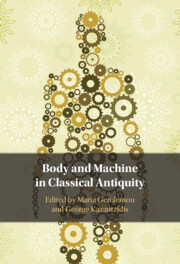Book contents
- Body and Machine in Classical Antiquity
- Body and Machine in Classical Antiquity
- Copyright page
- Contents
- Figures
- Contributors
- An Introduction to Body–Machine Intersections
- Part I Blended Bodies
- Part II The Technological Body
- Chapter 4 Technical Physicians and Medical Machines in the Hippocratic Corpus
- Chapter 5 The Empirical, Art and Science in Hippocrates’ On Joints
- Chapter 6 Hippocrates’ Diseases 4 and the Technological Body
- Part III Towards the Mechanization of the Human Body
- Index of Passages
- General Index
- References
Chapter 6 - Hippocrates’ Diseases 4 and the Technological Body
from Part II - The Technological Body
Published online by Cambridge University Press: 13 July 2023
- Body and Machine in Classical Antiquity
- Body and Machine in Classical Antiquity
- Copyright page
- Contents
- Figures
- Contributors
- An Introduction to Body–Machine Intersections
- Part I Blended Bodies
- Part II The Technological Body
- Chapter 4 Technical Physicians and Medical Machines in the Hippocratic Corpus
- Chapter 5 The Empirical, Art and Science in Hippocrates’ On Joints
- Chapter 6 Hippocrates’ Diseases 4 and the Technological Body
- Part III Towards the Mechanization of the Human Body
- Index of Passages
- General Index
- References
Summary
The Hippocratic treatise Diseases 4 is well known for explaining corporeal processes through vivid analogies with plants, cupping glasses, bronze vessels, swirling wine sediment, coagulating cheese, and blocked oil flasks. Scholars have often applied a heuristic dichotomy to these arguments, evaluating whether they are “mechanistic” (i.e., rely solely on recognizable physical forces) or “vitalistic” (i.e., attribute special capacities to living tissues and parts). Comparisons to implements tend to line up on the former side, while plant analogies support the latter. Rather than focus on delineating these two types of explanations, this chapter emphasizes that the author draws both sets of comparative objects from the therapies, implements, and techniques that a physician would have either administered to the body or encountered in the more general practice of medicine. Whether comparing the attractive capacity of the four inner “springs” (head, heart, gallbladder, spleen) to medicinal plants drawing up particular nutriment from the soil, or likening these same springs to bronze vessels, Diseases 4 amalgamates medical tools and the bodies that they treat. Its view of corporeality therefore emerges at the physical and conceptual interface between flesh and the therapeutic technologies that affect it, as the body absorbs and enfolds medical tools and substances.
Keywords
- Type
- Chapter
- Information
- Body and Machine in Classical Antiquity , pp. 155 - 178Publisher: Cambridge University PressPrint publication year: 2023



